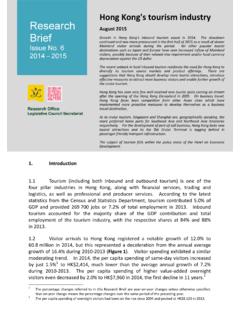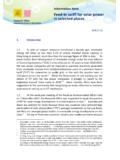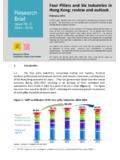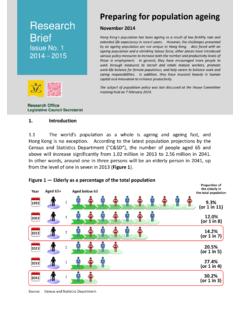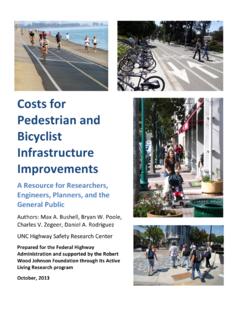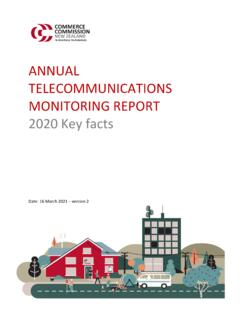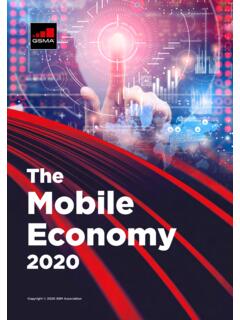Transcription of For discussion on 12 March 2018 Panel on ... - LegCo
1 LC Paper No. CB(4)701/17-18(03). For discussion on 12 March 2018. Legislative Council Panel on Information Technology and Broadcasting Key Infrastructure Projects for Smart City Development PURPOSE. This paper briefs Members on the three key infrastructure projects for smart city development proposed in the 2017 Policy Address, and seeks Members' support for submission of the funding proposals to the Finance Committee ( FC ). BACKGROUND. 2. The Chief Executive ( CE ) announced in the 2017 Policy Address to push ahead with the following three key infrastructure projects for smart city development: (a) provide an eID for all Hong Kong residents, allowing them to use a single digital identity and authentication to conduct government and commercial transactions online.
2 This will foster the development of a new economic service model that emphasises direct interface with residents and consumers;. (b) launch a pilot Multi-functional Smart Lampposts scheme at selected urban locations to support the building of a smart city with city-wide coverage of data and network. The Smart Lampposts will provide convenient data services and collect various real-time city data, enhance city and traffic management, and complement the future infrastructure development for fifth generation ( 5G ) mobile communications services in Hong Kong.
3 And (c) implement the Next Generation Government Cloud Infrastructure equipped with a new Application Architecture ( Next Generation GovCloud ) and a Big Data Analytics Platform to support the adoption of new cloud and system development technologies by government bureaux and departments ( B/Ds ), thereby expediting system development of e-government services, improving service level, and enhancing operation efficiency and cyber security. 3. We published the Smart City Blueprint for Hong Kong ( the Blueprint ) on 15 December 2017, outlining the vision and mission to build Hong Kong into a world-class smart city.
4 The Blueprint maps out development plans in the next five years, providing a clear and specific direction for smart city development in Hong Kong. The above three projects are included in the Blueprint. We briefed the Panel on the major contents of the Blueprint on 8 January 2018. PROPOSALS. 4. The ensuing paragraphs set out the Office of the Government Chief Information Officer ( OGCIO )'s proposals and funding arrangement for the three infrastructure projects. eID. 5. At present, more than ten countries around the world have already introduced electronic identity card or digital identity to facilitate their residents to access e-government services and other online services, including online banking, checking of medical records, tax returns, voting, etc.
5 6. We propose setting up a one-stop online eID system, as a key digital infrastructure for smart city, to enable residents to use electronic services and conduct online transactions in a more convenient and secure manner. The proposed eID could be regarded as a common key for digital identity authentication for members of the public to login and access various government and commercial electronic services in a simple and secure manner. eID would be made available for free for all Hong Kong residents to apply and use on voluntary basis.
6 7. In addition to logging in online accounts of the Government and public / private organisations, eID will support digital signing with -2- legal backing under the Electronic Transactions Ordinance (Cap. 553) for handling contracts, statutory documents and procedures, important commercial transactions, etc. 8. For e-government services, eID can be connected to different services. For example, it can be used to submit online applications for services like licence renewal, booking of venues, making appointments, etc.
7 , or document signing; authorise retrieval of information stored in electronic service system to pre-fill online forms or update address; and, by way of a unified identity authentication, facilitate the development of cross-departmental or institutional electronic services and streamline business processes. This could bring convenience to citizens and result in savings in conventional counter staff and resources. Our long-term goal is to make it mandatory for all government departments and public bodies to support the use of eID with a view to developing more innovative electronic services.
8 9. Besides, we will actively promote public and private organisations to adopt eID, in order to enable residents to use more online services under a single digital identity, such as online banking, online shopping, online payment and other e-commerce, etc. When designing the eID system, we will make technical provision and open up Application Programming Interfaces ( API ) to allow flexibility in supporting future services to be provided by public and private organisations. 10. Currently, government and commercial e-service providers are using different authentication systems to verify users' identity, such as username and password, secure token, SMS, etc.
9 With eID, residents can access various electronic services by way of a single login anytime and anywhere, so that they can enjoy consistent user experience, and avoid the inconvenience of managing different groups of usernames and passwords or carrying multiple secure tokens, thus bringing convenience to their daily living. We believe that the convenient and secure means of authentication through eID will not only facilitate people to access various kinds of electronic services, but also save the cost and time for government departments and commercial organisations, especially small and medium enterprises, in developing and operating individual user authentication systems, which in turn will promote the development of e- commerce in Hong Kong.
10 Having regard to the technology development trend and the public's habit of using smartphones, the registration and use of eID could be provided through mobile applications and other Internet platforms. -3- 11. We will adopt security standards that are widely recognised internationally to ensure that the eID system is secure and reliable. We will also consult the Office of the Privacy Commissioner for Personal Data and relevant government departments to ensure that the procedures are in line with the relevant requirements.
